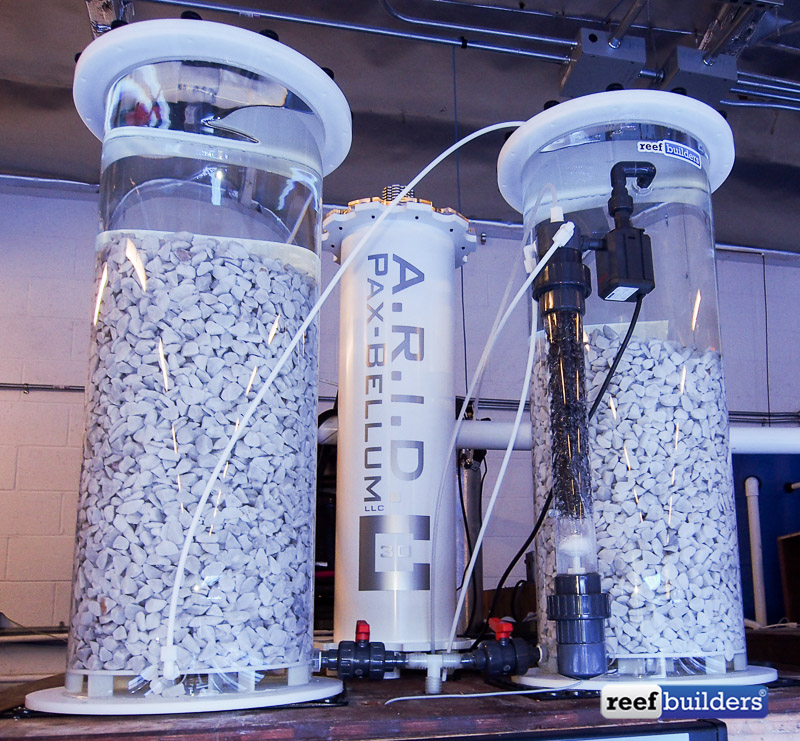They say that everything that is old will be new again, and this statement couldn’t ring any more true for the Pax Bellum ARID Chaetomorpha filters. In the early days of successful reef keeping, algae scrubbers and phyto-remediation was the state of the art for aquarium water quality control and nutrient export.
With improved protein skimming, better supplements, carbon dosing etc., in the last few decades we’ve gotten away from how effective algae can be at improving water quality. The ARID Filters from Pax Bellum are a 21st century approach to creating a filtration space which is dedicated to intensive Chaetomorpha culture.


About two weeks ago we had the opportunity to test drive one of Pax Bellum’s largest single ARID filters, on one of Unique Corals‘ largest coral systems, clocking in at around 5,000 gallons. Better yet, the model that we tested was specially fitted to pair up with a calcium reactor, so we installed it downstream of the new jumbo Dastaco calcium reactor we also installed on this huge volume of reef aquarium water.
What makes the ARID filter truly unique is that it takes a no-holds barred approach to growing macroalgae, with intense light, a dedicated vessel with discrete inlets and outlets for maximum water pass through the algae mass. Any reefer with a touch of DIY skills can set up a spare tank to put in line with the system and grow Chaetomorpha, but the ARID is specially designed to concentrate a large volume of live macroalgae into a small volume with a small footprint.

Naturally, most reefers will look towards this kind of dedicated vegetative nutrient export to reduce and remove levels of nitrates and phosphates. In our test case the system already runs very low nutrients, and we therefore looked to the ARID primarily to absorb the carbon dioxide from the highly acidic effluent of the Dastaco, and to produce Chaetomorpha for resale as a byproduct.
No matter what your reasons are for growing lots of Chaeto, the ARID filters are by and large the most sophisticated way to make that Chaeto grow. The ARID is also one of the few devices we’ve ever tested which we didn’t want to modify in any way – we saw a prototype of this device nearly five years ago when it was just running a T5 tube down the center, and it’s abundantly clear that abundant refinements have been applied in the intervening years to create one very polished piece of aquarium equipment.

The build quality of the ARID is completely top of the line, and somewhat overbuilt in many aspects. The model we tested is made of solid PVC pipe with a clear lid that removes easily with a keyhole flange. Every cut on the ARID has a beveled edge giving that fit and finish that we love to see in acrylic aquarium equipment. And of course we’ve already reported specifically on the vapor-heatsink tube of LED lighting that slides down the center of the ARID providing the macroalgae within all the light it could ever need.

The model we tested had a custom-designed venturi valve on the inlet with specially designated positive and negative pressure ports for feeding and receiving water from the calcium reactor. Another really nice touch to the ARID filters is the use of small quick disconnect barbs for the feed and drain hoses which made servicing the whole unit a breeze.
Like we said we test drove the ARID C-30 for just under two weeks and in that time, the tiny mass of Chaetomorpha that we seeded the filter with had turned into a nearly completely solid layer cake of green algae tissue. We didn’t specifically measure the mass before it went in the ARID, but what must have been a few ounces of Chaetomorpha turned into 1.63 pounds in record time, wet weight.

If we let the ARID C-30 run for a full month, we estimate that the ARID C-30 could easily produce five pounds (2.25Kg) in 30 days, wet weight. This estimation is provided that the Chaetomorpha suffers no deficiencies of trace elements or carbon dioxide and your mileage may vary.
And this gets us to the only true Achille’s Heel of the ARID algae scrubber: unlike our mechanical devices which run simply on power, the Chaetomorpha that is used inside ARID filters is a living thing and you’ll need to take care of it in certain ways. To keep the Chaetomorpha growing as well as possible it will be necessary to regularly dose with iron, molybdenum, and to a lesser degree iodine. Concentrations of each of these will be rapidly taken up by the living algae and regular additions of them will also benefit the health of your entire reef aquarium and animals anyway.

If there’s one catch to the ARID filters from Pax Bellum it’s that they are expensive, and not necessarily that easy to use. The price of a single Pax Bellum ARID filter is not yet in mass market territory and as far as we know they are being built to order. So far the primary interest in the ARID filters have been from advanced hobbyists and professional aquarium service technicians looking for a sure fire way to reduce nitrates in heavily stocked reef tanks.
Those caveats aside, we will strongly consider using Chaetomorpha for ameliorating the pH condition of our next reef tank, and particularly for scavenging carbon dioxide from the calcium reactor effluent. There’s no doubt that the Pax Bellum ARID is one of the most effective ways to intensively culture chaetomorpha in a small space and volume and we look forward to learning what results other reefers have with them in the future. [A.R.I.D.]





